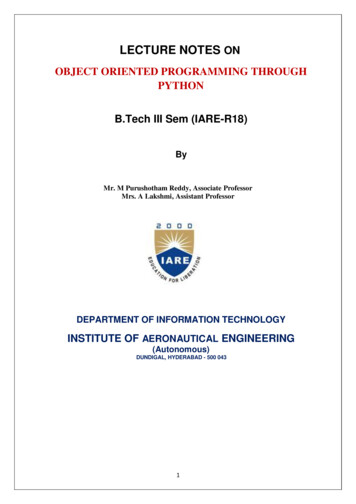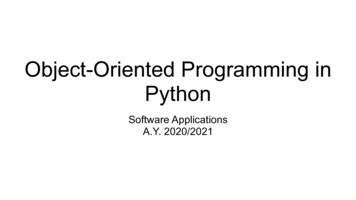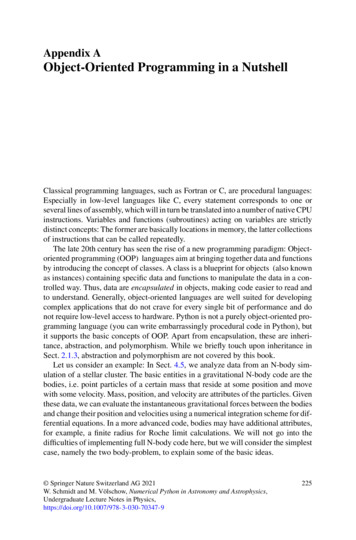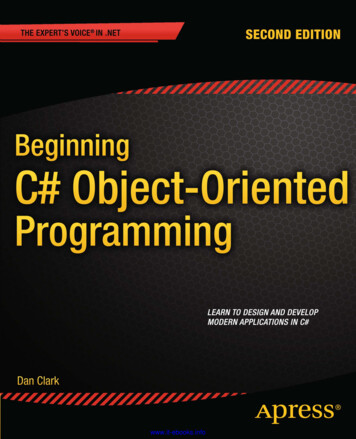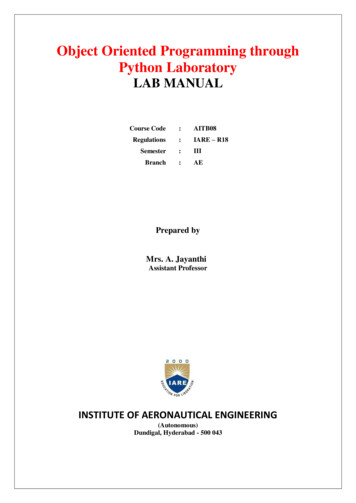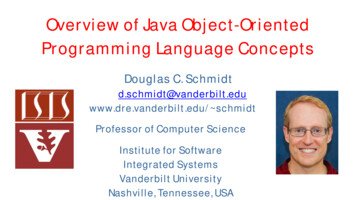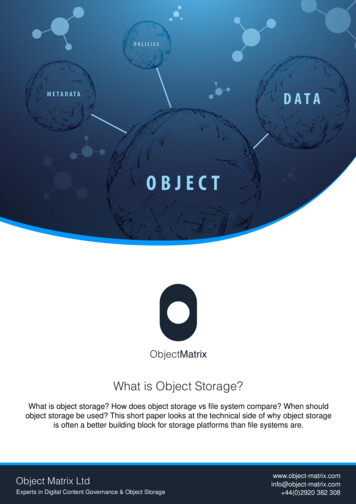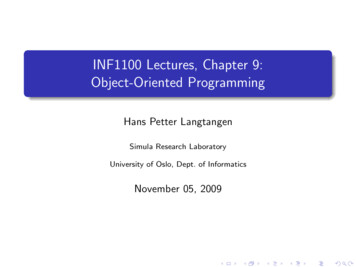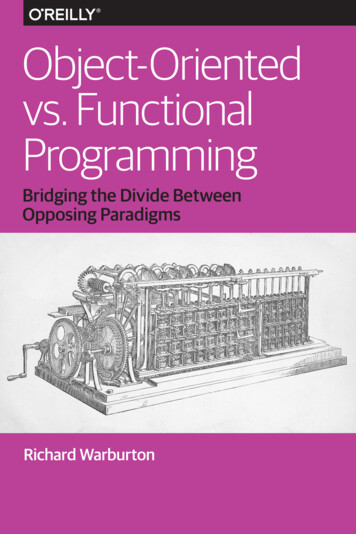
Transcription
Course Title: Object Oriented Programming in Java (3 Cr.)Course Code: CACS204Year / Semester: II / IIIClass Load: 6 Hrs. / Week (Theory: 3 Hrs. Tutorial: 1 Hr. Practical: 2 Hrs.)Course DescriptionThis course covers preliminary concepts of object-oriented approach in programming with basic skills using Java. Control structures, Classes, methods andargument passing and iteration; graphical user interface basics programming and documentation style.Course ObjectivesThe general objectives of this course are to provide fundamental concepts of Object Oriented Programming and make students familiar with Java environmentand its applications.Course Detail Specific ObjectivesDefine Java programming language and exploring itshistoryExplore role of Java for developing InternetapplicationsExplain applications and applets development in Javaand their comparisonsDefine Java Virtual Machine and its roleKnow bytecode and its executionExplain and compare procedure and object orientedprogrammingKnow how to compile and run Java programsInstalling and setting environment variables for JavaenvironmentKnow to write Java programsKnow to compile, interpreter and run Java programsKnow to handle common Java programming errorsand removing themCourse ContentHours2 Hrs.Unit 1 : Introduction to Java1.1 Definition and History of Java1.2 The Internet and Java‟s Place in IT1.3 Applications and Applets1.4 Java Virtual Machine1.5 Byte Code – not an Executable code1.6 Procedure – Oriented vs. ObjectOriented Programming1.7 Compiling and Running a SimpleProgram1.8 Setting up your Computer for JavaEnvironment1.9 Writing a Program1.10Compiling, Interpreting andRunning the Program1.11Handling Common Errors1References1. Chapter 1: Deitel & Deitel, “Java:How to program”, 9th Edition,Pearson Education, 2011,ISBN:97802737597682. Chapter 1 and 2: Herbert Schildt,“Java: The Complete Reference”,Seventh Edition, McGraw-Hill2006, ISBN: 0072263857
Define data type and explain all primitive data typesand their usesDefine and explain user-defined data typesKnow to declare variables and constants, use identifiersand literalsConvert one data type to other; Automatic and explicitconversionKnow to declare and assign values to variablesExplain default variable initializationKnow to use command line argumentsDefine array and use array of primitive typesKnow to use different styles of writing commentsKnow about garbage collection features in JavaDefine and use expressionsKnow to use different types of operatorsExplain and know to use all control statements:branching, looping, and jumpDefining classes and objects; Know to create classesand objects; Adding and calling members to classesDefine and explain abstraction and encapsulationExplain and know to use „this‟ keywordDefine and explain different types of constructors andtheir importance in Java programmingKnow to pass parameters in methods: by value and byreferenceUnit 2 : Tokens, Expressions andControl Structures2.1 Primitive Data Types: Integers,Floating-Point types, Characters,Booleans2.2 User-Defined Data Types2.3 Declarations, Constants, Identifiers,Literals2.4 Type Conversion and Casting2.5 Variables: Variable Definition andAssignment2.6 Default Variable Initializations2.7 Command-Line Arguments2.8 Arrays of Primitive Data Types2.9 Comment Syntax2.10Garbage Collection2.11Expressions2.12Using Operators: Arithmetic,Bitwise, Relational, Logical,Assignment, Conditional, Shift,Ternary, Auto-increment and Autodecrement2.13Using Control Statements(Branching: IF, Switch; Looping:While, do-while, for; Jumpingstatements: break, continue andreturnUnit 3 : Object OrientedProgramming Concepts3.1 Fundamentals of Classes: A SimpleClass, Creating Class Instances,Adding methods to a class, CallingFunctions/Methods3.2 Abstraction, Encapsulation3.3 Using „this‟ keyword21. Chapter 4, 5, 7 and 8: Deitel &Deitel, “Java: How to program”, 9thEdition, Pearson Education, 2011,ISBN:97802737597682. Chapter 3, 4 and 5: Herbert Schildt,“Java: The Complete Reference”,Seventh Edition, McGraw-Hill2006, ISBN: 00722638575 Hrs.9 Hrs.1. Chapter 3, 6, 8, and 18: Deitel &Deitel, “Java: How to program”, 9thEdition, Pearson Education, 2011,ISBN:97802737597682. Chapter 6 and 7: Herbert Schildt,“Java: The Complete Reference”,Seventh Edition, McGraw-Hill2006, ISBN: 007226385
Know to use different access control techniquesExplain return values from methodsDefine, explain, and implement polymorphism andoverloadingRecursion, recursive method, and its importanceKnow to use and importance of nested and innerclasses Know to use extends keyword for inheritanceConcept of subclass and superclassKnow to use „super‟ keyword add its useKnow to write programs using method overridingConcept of dynamic method dispatch and its usesKnow the concept of Object class and its membersExplain and compare abstract and final classesDefine and Know to use packagesExplain and use different access control techniquesKnow the concept and uses of interfaces includingdefinition and implementation of interfaces Know the concept and uses of exceptionsKnow to create user defined exceptionsException handling using „try‟ and „catch‟ keywordsKnow to use‟ throw‟ and „throws‟ keywordsKnow to use finally clause and its uses3.4 Constructors, Default Constructors,Parameterized Constructors3.5 More on Methods: Passing byValue, by Reference3.6 Access Control3.7 Methods that Return Values3.8 Polymorphism and MethodOverloading3.9 Recursion3.10Nested and Inner ClassesUnit 4 : Inheritance & Packages4.1 Inheritance: Using „extends‟keyword4.2 Subclasses and Superclasses4.3 „super‟ Keyword Usage4.4 Overriding Methods4.5 Dynamic Method Dispatch4.6 The Object Class4.7 Abstract and Final Classes4.8 Packages: Defining a Package,Importing a Package4.9 Access Control4.10Interfaces: Defining anInterface, Implementing andApplying InterfacesUnit 5 : Handling Error/Exception5.1 Basic Exceptions, Proper Use ofExceptions5.2 User Defined Exceptions5.3 Catching Exception: try, catch5.4 Throwing and Re-throwing: throw,throws5.5 Cleaning Up Using the finallyClause33 Hrs.1. Chapter 9 and 10: Deitel & Deitel,“Java: How to program”, 9thEdition, Pearson Education, 2011,ISBN:97802737597682. Chapter 8 and 9: Herbert Schildt,“Java: The Complete Reference”,Seventh Edition, McGraw-Hill2006, ISBN: 0072263852 Hrs.1. Chapter 11: Deitel & Deitel, “Java:How to program”, 9th Edition,Pearson Education, 2011,ISBN:97802737597682. Chapter 10: Herbert Schildt, “Java:The Complete Reference”, SeventhEdition, McGraw-Hill 2006, ISBN:007226385
Know to use different string operationsExplain StringBuffer class and its comparison withString classUnit 6 : Handling Strings6.1 Creation, Concatenation andConversion of a String, ChangingCase, Character Extraction, StringComparison, Searching Strings,Modifying Strings6.2 String Buffer2 Hrs. Know to create, instantiate, and start a new threadKnow to write multithreaded programs using ThreadclassKnow to write multithreaded programs using RunnableinterfaceUnderstand thread execution and its states duringexecutionKnow the concept of thread prioritiesKnow the concept of thread synchronizationExplain inter-thread communicationConcept of deadlock and deadlock handlingKnow to use java.io package and its different classesKnow to read and write data to and from consoleKnow to read and write files from Java programsConcept of serialization and deserializationUnit 7 : Threads7.1 Create/Instantiate/Start NewThreads7.2 Extending java.lang.Thread7.3 Implementing java.lang.RunnableInterface7.4 Understanding Thread Execution7.5 Thread Priorities7.6 Synchronization7.7 Inter-Thread Communication7.8 Deadlock3 Hrs.Unit 8 : I/O and Streams8.1 java.io Package, Files andDirectories, Streams: Byte Streamsand Character Streams8.2 Reading/Writing ConsoleInput/Output8.3 Reading and Writing Files8.4 The Serialization Interface,Serialization & DeserializationUnit 9 : Understanding CorePackages9.1 Using java.lang Package:java.lang.Math, Wrapper Classesand Associated Methods (Number,Double, Float, Integer, Byte, Short,2 Hrs.1. Chapter 17: Deitel & Deitel, “Java:How to program”, 9th Edition,Pearson Education, 2011,ISBN:97802737597682. Chapter 13: Herbert Schildt, “Java:The Complete Reference”, SeventhEdition, McGraw-Hill 2006, ISBN:0072263853 Hrs.1. Chapter 16, 17 and 18: HerbertSchildt, “Java: The CompleteReference”, Seventh Edition,McGraw-Hill 2006, ISBN:007226385 Concept of java.lang packate; Know to use java.langpackage and its different classesConcept of java.util packate; Know to use java.utilpackage and its core classes41. Chapter 3 and 16: Deitel & Deitel,“Java: How to program”, 9thEdition, Pearson Education, 2011,ISBN:97802737597682. Chapter 15: Herbert Schildt, “Java:The Complete Reference”, SeventhEdition, McGraw-Hill 2006, ISBN:0072263851. Chapter 26: Deitel & Deitel, “Java:How to program”, 9th Edition,Pearson Education, 2011,ISBN:97802737597682. Chapter 11: Herbert Schildt, “Java:The Complete Reference”, SeventhEdition, McGraw-Hill 2006, ISBN:007226385
Concept of arrays and different collection classes andassociated interfacesConcept of map, list, and set and their usesKnow to use different collection classes like array list,linked list, hash set and tree setKnow to access collections using iterator andcomparatorExplain and compare AWT and swingKnow to use JFrame as a top level containerExplain and know to use different swing componentsKnow to use IDEs for developing Java applicationsConcept and uses of adapter classes; Compare adapterclasses with event listenersLong, Character, Boolean)9.2 Using java.util Package: CoreClasses (Vector, Stack, Dictionary,Hashtable, Enumerations, RandomNumber Generation)Unit 10 : Holding Collection of Data10.1 Arrays and Collection Classes andInterfaces10.2 Map/List/Set Implementations:Map Interface, List Interface, SetInterface10.3 Collection Classes: Array, List,Linked List, Hash Set and Tree Set10.4 Accessing Collections/Use of AnIterator/ComparatorUnit 11 : Java Applications11.1 About AWT & Swing11.2 About JFrame (a Top LevelWindow in Swing)11.3 Swing Components (JLabel, AboutText Component like JTextField,JButton, Event Handling in SwingApplications, Layout Managementusing Flow Layout, Border Layout,Grid Layout, Using JPanel, ChoiceComponents like JCheckBox,JRadioButton, BordersComponents, JComboBox & itsevents, JList & its events withMVC Patterns, Key and MouseEvent Handling, Menus in Swing,JTextArea, Dialog Boxes in Swing,JTable for Displaying Data inTabular form, MDI using JDesktoPane & JInternet Frame)53 Hrs.1. Chapter 7 and 20: Deitel & Deitel,“Java: How to program”, 9thEdition, Pearson Education, 2011,ISBN:97802737597682. Chapter 17: Herbert Schildt, “Java:The Complete Reference”, SeventhEdition, McGraw-Hill 2006, ISBN:0072263858 Hrs.1. Chapter 14 and 25: Deitel & Deitel,“Java: How to program”, 9thEdition, Pearson Education, 2011,ISBN:97802737597682. Chapter 23, 24, 29 and 30: HerbertSchildt, “Java: The CompleteReference”, Seventh Edition,McGraw-Hill 2006, ISBN:007226385
Define applet and compare it with applicationsExplain different applet life cycle methodsKnow to build simple appletsKnow to use appletviewer commandKnow to add different controls to applits Know to use JDBC to connect with databases usingconnection classConcept of statement and result set to manipulate datain the database 11.4 Using like NetBeans, JBuilder forbuilding java applications usingDrag & Drop11.5 Adapter ClassesUnit 12 : Introduction to JavaApplets12.1 Definition12.2 Applet Lifecycle Methods12.3 Build a Simple Applet12.4 Using Applet Viewer12.5 Adding Controls: AnimationConceptsUnit 13 : Database Programmingusing JDBC13.1 Using Connection13.2 Statement & Result Set Interfacesfor Manipulation Data withDatabases1 Hr.1. Chapter 23: Deitel & Deitel, “Java:How to program”, 9th Edition,Pearson Education, 2011,ISBN:97802737597682. Chapter 13: Herbert Schildt, “Java:The Complete Reference”, SeventhEdition, McGraw-Hill 2006, ISBN:0072263852 Hrs.1. Chapter 28: Deitel & Deitel, “Java:How to program”, 9th Edition,Pearson Education, 2011,ISBN:9780273759768Teaching MethodsThe general teaching methods includes class lectures, group discussions, case studies, guest lectures, research work, project work, assignments(theoretical andpractical), and exams, depending upon the nature of the topics. The teaching faculty will determine the choice of teaching pedagogy as per the need of thetopics.EvaluationInternal AssessmentTheoryPractical2020 (3 Hrs.)Evaluation SchemeExternal AssessmentTheoryPractical60 (3 Hrs.)-6Total100
Internal/Practical Assessment Format [FM 40]Internal Assessment Format [FM 20] – Subject TeacherTerm ExaminationAssignmentAttendanceTotalMid – TermPre - Final555520Practical Assessment Format [FM 20] – External Examiner will be assigned by Dean Office, FOHSS.PracticalVivaLab ReportsTotal105520Note: Assignment may be subject specific case study, seminar paper preparation, report writing, project work, research work, presentation, problem solving etc.Final Examination Questions Format [FM 60, PM 24, Time 3 Hrs.]SNQuestion TypeNumber of Questions Given Marks per QuestionGroup – 'A'101Objective Type Questions(Multiple Choice Questions)Group – 'B'75Short Questions (Attempt any SIX questions)Group – 'C'310Long Questions (Attempt any TWO questions)123 Total Marks10 x 1 106 x 5 302 x 10 20Student must pass 'Internal Assessment', 'Practical Assessment' and 'Final Examination' separately.Student must attend each and every activity of 'Internal Assessment' otherwise he/she will be declared as 'Not Qualified' for final Examination.Text Books12Deitel & Deitel, “Java: How to program”, 9th Edition, Pearson Education, 2011, ISBN:9780273759768Herbert Schildt, “Java: The Complete Reference”, Seventh Edition, McGraw-Hill 2006, ISBN: 0072263857Reference Books123Bruce Eckel, “Thinking in Java”, 4th Edition, Prentice Hall, 2006, ISBN: 0-13-187248-6Cay Horstmann ad Grazy Cornell, “Core Java Volume I – Fundamentals”, Ninth Edition, Prentice Hall, 2012, ISBN: 978-013708199E. Balagurusamy, “Programming with Java: A Primer”, 4th Edition, Tata McGraw Hill Publication, India7
Internal Assessment marks Submission formatCampus Name:Subject Name: Digital LogicSubject Code: CACS105SN TU Registration No. Name Symbol No. Mid – Term [5] Pre – Final [5] Assignment [5] Attendance [5] Total [20] RemarksName of Subject Teacher:Name of Date:8
Tribhuvan UniversityBachelor in Computer Application (BCA) – 3rd SemesterObject Oriented Programming in Java (CACS204)Laboratory Report format1. Title:2. Objectives:3. Source Code:4. Input:5. Output:6. Remarks/Comments:9
Laboratory ActivitiesThe laboratory works includes writing computer programs using Javaprogramming language as given below. Writing simple programs to demonstrate command line arguments Writing programs that include variables, data types, and operators Writing programs that include all control statements Writing programs with arrays Writing programs with classes and inheritance Writing programs with concepts of packages Writing programs with exception handling Writing programs to handle string methods Writing multithreaded programs using Thread and Runnable Writing programs with console and file input/output Writing programs using java.lang and java.util classes and interfaces Writing programs using collection classes Writing GUI programs using swing components, event handling, andlayout management Writing Java applets Writing programs using JDBC to handle databases10
TribhuvanUniversityFaculty of Humanities & Social SciencesOffice of the DeanFinal Examination 2019Bachelor in Computer ApplicationsSemester: ThirdCourse Title: OOP in JavaCode No: CACS204Full Marks: 60Pass Marks: 24Time: 3 hoursName:Symbol No:Candidates are required to answer the questions in their own words as far as possible.Group “A”Attempt all the questions.10 1 10Encircle the most appropriate answer from the given choices.1. Which one of the following is not a valid java bitwise operator?a) b) c) d) 2. Which one of the following keyword is used to declare an exception?a) throwsc) try3. Which of these is an incorrect array declaration?a) intary[] new int[5];c) intary int[5] new;4.5.6.7.8.9.10.b) throwd) catchb) int[] ary new int[5];d) intary[];ary new int[5];Which one of the following access specifier is appropriate formembers of superclassto access onlyfrom subclass?a) privateb) protectedc) publicd) defaultWhich one of the following is not a collection class defined in java?a) Linked Listb) Hash Setc) Tree Setd) Graph SetWhich one of the following inheritance is best implanted using interface in java?a) single inheritanceb) multi-level inheritancec) multiple inheritanced) hierarchical inheritanceWhich one of the following method is called only once during the run time of your applet?a) stop()b) paint()c) init()d) start()Which of these method of class String is used to compare two String objects for their equality?a) equals()b) Equals()c) isEqual()d) IsEqual()What is the default value of priority variable MIN PRIORITY and MAX PRIORITY?a) 0 & 63b) 1& 10c) 0 & 1d) 1 & 32Which one of the following is not java swing container?a) Panelb) TabbedPanec) Scroll Paned) Scroll bar11
TribhuvanUniversityFaculty of Humanities & Social SciencesOffice of the DeanFinal Examination 2019Bachelor in Computer ApplicationsSemester: ThirdCourse Title: OOP in JavaCode No: CACS204Full Marks: 60Pass Marks: 24Time: 3 hoursCandidates are required to answer the questions in their own words as far as possible.Group “B”Attempt any SIX questions.6 5 301.2.3.4.Define OOP. Explain features of Object Oriented Programming Language. [1 4]Explain different types of control statements used in java. [5]Define Abstract Class. Explain different types of Access controls available in java. [1 4]Define method overriding? Write any program to implement concept of multiple inheritance inJava.[1 4]5. Why it is important to handle exception in java? Write a program to illustrate the use ofexception handling [1 4]6. Define the use of static keyword. Write any four String methods used in java withexample.[1 4]7. Define super, final and this keywords in java. Explain the concept of MVC in brief.[1 1 1 2]Group “C”Attempt any TWO questions.2 10 208. a) Define multithreading. Write a java program to show the inter-thread communication.[1 4]b) Define Stream. Write a program in java to copy the content from one file to another.[1 4]9. a) Define Collection Class. Explain different Wrapper classes and associated methods injava. [1 4]b) Define AWT. Explain different types of Layout Managers in java. [1 4]10. a) List and explain any five swing controls with their uses. [5]b) Define JDBC. Write a program to display all records from a table of database.[1 4]Answer Key12da3c4b5d6c127c8a9b10d
1. Chapter 26: Deitel & Deitel, "Java: How to program", 9 Edition, Pearson Education, 2011, ISBN:9780273759768 2. Chapter 11: Herbert Schildt, "Java: The Complete Reference", Seventh Edition, McGraw-Hill 2006, ISBN: 007226385 Unit 8Know to use java.io package and its different classes Know to read and write data to and from console
